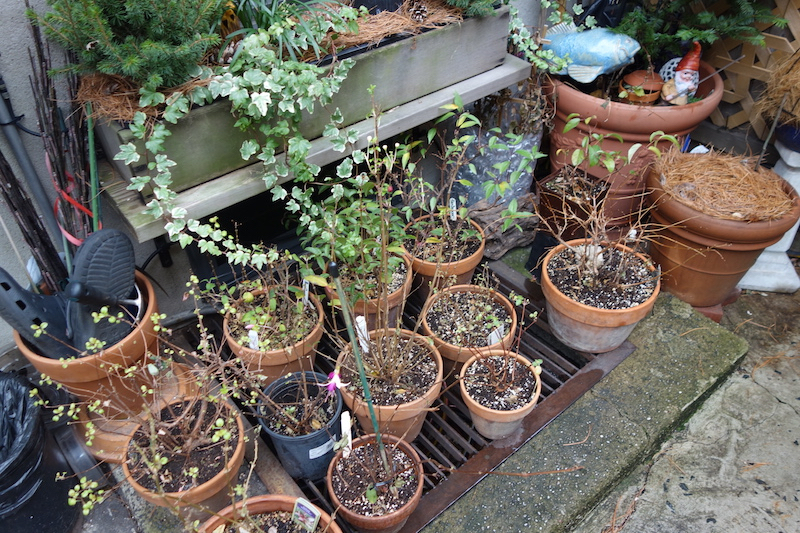Overwintering potted fuchsias made simple
Lots of people treat their potted fuchsias like summer annuals. There’s no real reason to do that. Don’t toss the plants on the compost heap at the end of the growing season, like some cheap floosy of a petunia you picked up at the box store. Or any of the other warm-weather garden affairs you’ve been having. Don’t let Jack Frost take out the fuchsias. They're worth saving, especially if you have a favorite cultivar that isn’t easy to come by. By all means bring the pots in.
Keep a few things in mind, though.

Rest is important
Even if you have a greenhouse or a sunny porch, give the fuchsias a rest. Fuchsias appreciate the down time while the light’s dim. Your main goal is just keeping them alive—not blooming—though the winter gloom. They won’t even need light during their long winter’s nap. Hopefully not too long a nap, for the impatient gardener’s sake as well.
Choose a cool spot
Choose a spot that’s cool but stays frost free. Ideally about 40-45° F (4-7° C). A little colder is fine. Bit warmer works as well. Even a bit alot warmer. Don’t worry if you don’t have a brightly lit spot either. They won’t be growing actively. You can even stick them in a dark closet, in a garage, a shed, the cellar, under the bench in the greenhouse. Any place that’s convenient to store them away, just as long as it’s relatively cool and there’s no danger of falling below freezing.
Cut back on watering
The next step is to cut back on watering. Your fuchsia will start losing leaves. Again, don’t worry. You want the plant to think it’s dormant. Fuchsias don’t actually go truly dormant in the winter in the same way outdoor maples might, for example. You just want them to think they’re dormant. Cool and dry will help accomplish this illusion.
In fact, go ahead and pull off all the old, green leaves. Yes, do it. It speeds the process. Cuts down on bugs and other unwanted what-nots overwintering along with the plants as well. Don’t cut the branches back. Yet. There's good reason for waiting. Cutting back encourages new shoots to break. You want rest not active growth. New shoots in the wan light of winter will be weaker and just sap the strength of the plant. Be patient.
For the next few months you’ll be giving the plants minimal water. Just enough to keep them in suspended animation. Once a week maybe? Every couple of weeks? Longer? How much really depends on how cool they are. Or how large the pot or planter is. Is it porous clay or impermeable plastic? A smidgeon twice a week for a small clay pot? If the temperatures in storage are warmer than ideal, moisture evaporates faster and they’ll need slightly more. Monitor them. They’re not cactuses after all. They’re just napping.
If you’re unsure that you’re doing a good job withholding water, nick the bark towards the end of a branch ever-so slightly with your nail. If a fleck of green shows, it’s still alive. That part anyway. Like I said, don’t trim the branches. You’ll do that in the spring. There will be some dieback and keeping the branches intact helps protect the lower, inner parts as well.
Prune in the spring
When the days get longer and warmer, you can bring the plants back out. Maybe about a month before your regularly scheduled last frost. Sooner of you have a nice greenhouse. They’ll probably look a bit bedraggled, a tangle of pale shoots that couldn’t wait no matter how carefully you balanced the temperature and water. Now is the time to prune all the old branches back. Aim for shapely form and balance. Don’t worry about going too far. Fuchsias will send out new growth even from old wood.
Repot in fresh soil
Lift the plant from the pot and knock off a good amount of the tired old compost. Repot with fresh. Choose a good mix that stays evenly moist but is well-draining. Don’t push down hard—fuchsias don’t like compacted soil—but settle the mix in gently by tapping the bottom of the pot against the top of the plant bench. Resume regular watering. Be careful not to overwater at first as the new roots develop their way in the new soil. Empty soil that’s too wet will cause old roots to rot instead of sending new ones eagerly off into it.
Start feeding again. And pinch your fuchsias!
Start feeding regularly with a weak mix in a week or two. Don’t forget to pinch for bushiness at least a couple of times. You can set the plants back outside in a bright spot now, out of the direct sun, as long it doesn’t fall below freezing. They won’t mind the cool. Don’t forget to bring them back under cover if a frost threatens. It’d be a shame to loose the poor things after the effort. Not that any of us have ever done that.

It really is easy to overwinter potted fuchsias. I live in a city apartment. In Manhattan. When it comes time to bring pots in from the garden in the fall, I don’t have a greenhouse, a garage, a shed, the cellar, or even a spare closet. Just a cool window and a rack of shelving by the garden door. Anything but ideal conditions. And the fuchsias still manage fine.